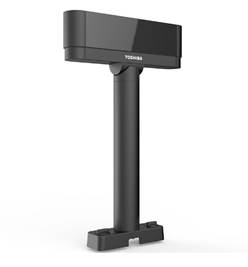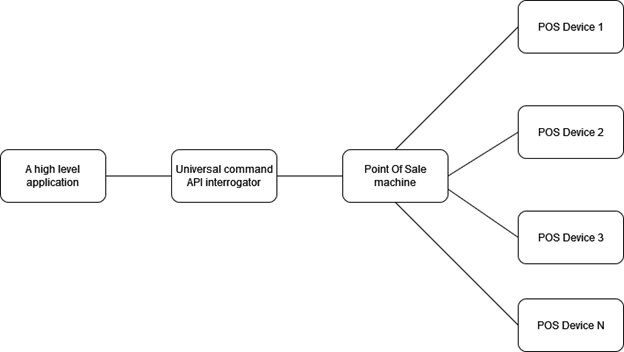Authors:
Abraham Ramos, Fredy Serrano, Jose Garnica, Mauricio Herrera, Hildebrando Carballido
Abstract:
A POS (Point of Sale) Peripheral device is capable of providing inventory management information, which is described through a specialized set of properties that show its basic fundamental characteristics. This proposal uses an alternate mechanism based on an EPROM (Electrically Erasable Programmable Read-Only Memory) integrated circuit.
This EPROM (Electrically Erasable Programmable Read-Only Memory) integrated circuit shall be included in the POS (Point Of Sale) Peripheral device at the time of manufacture with the data and the set of properties already coded.
The current proposal is for POS (Point Of Sale) Peripheral devices that are connected to a POS (Point Of Sale) machine through different communication ports, such as USB.
This proposal also applies to hardware devices that are not categorized as POS (Point of Sale) but are still used in the Retail industry, such as network cameras, for purposes like loss prevention, product recognition, etc.
Furthermore, any other hardware device that can be connected to the Store infrastructure can also be considered for this proposal. The inclusion of an EPROM integrated circuit in these devices could significantly enhance their functionality and value from the inventory management standpoint.
While providing an EPROM integrated circuit at the time of manufacture may initially increase the cost of production, it offers significant long-term economic benefits. This approach is more cost-effective than assuming the cost of including the continuous programming development code effort of the Device Drivers, which demand frequent updates, fixes, and deployments, thereby saving time and resources for the commercial customer's daily business operations.
The list of POS (Point of Sale) Peripheral devices is long. For practical purposes, the following are considered part of the current proposal.
POS LineDisplay
POS Keyboard
POS CashDrawer
POS Printer
POS VideoDisplay
Background:
Collecting Inventory management information through traditional Device Drivers is a mix of two fundamental operations: handling the POS (Point Of Sale) Peripheral device through the operating system and making it available for the customer's business and sales applications, on the one hand, and providing the inventory management information, on the other hand.
The current methods incur significant long-term costs. This is due to the continuous need for updates for the Device Drivers to address issues reported from the field and maintain the health of the hardware POS (Point Of Sale) Peripheral device. Our proposed solution aims to reduce these ongoing costs.
Therefore, our proposed alternate method for collecting inventory management information of the POS (Point Of Sale) Peripheral hardware devices, independent of the Device Drivers and other protocols, represents a promising solution. It not only simplifies the process but also reduces long-term costs, offering a more efficient and cost-effective approach.
Most importantly, it will let the commercial customer still collect inventory information of the Retail hardware assets through the whole chain, regardless of whether it is correctly being handled by the different Device Drivers or protocols of communication.
Description:
Collecting Inventory management information through traditional Device Drivers is a mix of two fundamental operations: handling the POS (Point Of Sale) Peripheral device through the operating system and making it available for the customer's business and sales applications, on the one hand, and providing the inventory management information, on the other hand.
This proposal uses an alternate mechanism based on an EPROM (Electrically Erasable Programmable Read-Only Memory) integrated circuit.
This EPROM (Electrically Erasable Programmable Read-Only Memory) integrated circuit shall be included in the POS (Point Of Sale) Peripheral device at the time of manufacture with the data and the set of properties already coded.
Main idea and technology:
It is presented in stages.
Stage 1, Store in the EPROM the basic set of properties for each POS (Point Of Sale) Peripheral Device.
Include an EEPROM (Electrically Erasable Programmable Read-Only Memory) of 512 bytes as part of the electronic circuit board of a POS (Point Of Sale) Peripheral hardware device at manufacture design time.
The 512-byte EEPROM (Electrically Erasable Programmable Read-Only Memory) contains hexadecimal information consisting of properties and a value. The information describes the characteristics of the POS (Point Of Sale) Peripheral hardware device. In other words, it is inventory management information.
Each POS (Point Of Sale) Peripheral Device has its own set of properties that describe its characteristics according to its functionality and service. These properties are described in detail in the Functional Hardware Specification PDF document for each of the POS (Point Of Sale) Peripheral Devices. All and each one of the different manufacturers should provide this document. On the other hand, there is the Unified JavaPOS Standard document that defines the official suggested set of properties for each one of the known POS (Point Of Sale) Peripheral Devices as far as the latest version. This current proposal document suggests the properties for each Device that describe its most important characteristics that are relevant from a management inventory standpoint for commercial customers. Here is the description for each Device.
POS Line Display.

<attribute id="DeviceName" type="text" value="POS LineDisplay" />
<attribute id="ModelName" type="text" value="Single-Sided 2x20 Display" />
<attribute id="ManufacturerName" type="text" value="Toshiba" />
<attribute id="DeviceDescription" type="text" value="2x20, 2 Lines of 20 characters, 27 code pages" />
<attribute id="SerialNumber" type="text" value="T-12345" />
<attribute id="Bus" type="text" value="USB 2.0, Full Speed" />
<attribute id="ManufactureDate" type="text" value="January 1, 2024" />
<attribute id="DeviceID" type="text" value="31" />
<attribute id="ProductID" type="text" value="45" />
<attribute id="VendorID" type="text" value="89" />
<attribute id="IsOnline" type="boolean" value="true" />
POS Keyboard

<attribute id="DeviceName" type="text" value="POS Keyboard" />
<attribute id="ModelName" type="text" value="Modular 67-Key POS LCD Keyboard" />
<attribute id="ManufacturerName" type="text" value="Toshiba" />
<attribute id="DeviceDescription" type="text" value="67-Key reconfigurable keyboard" />
<attribute id="SerialNumber" type="text" value="K-12345" />
<attribute id="Bus" type="text" value="USB 2.0, Full Speed" />
<attribute id="ManufactureDate" type="text" value="January 1, 2024" />
<attribute id="DeviceID" type="text" value="32" />
<attribute id="ProductID" type="text" value="46" />
<attribute id="VendorID" type="text" value="90" />
<attribute id="IsOnline" type="boolean" value="true" />
POS Cash Drawer

<attribute id="DeviceName" type="text" value="POS CashDrawer" />
<attribute id="ModelName" type="text" value="Flip-Top Cash Drawer" />
<attribute id="ManufacturerName" type="text" value="Toshiba" />
<attribute id="DeviceDescription" type="text" value="Steel with stainless steel top" />
<attribute id="SerialNumber" type="text" value="CD-12345" />
<attribute id="Bus" type="text" value="USB 2.0, Full Speed" />
<attribute id="ManufactureDate" type="text" value="January 1, 2024" />
<attribute id="DeviceID" type="text" value="33" />
<attribute id="ProductID" type="text" value="47" />
<attribute id="VendorID" type="text" value="91" />
<attribute id="IsOnline" type="boolean" value="true" />
POS Printer

<attribute id="DeviceName" type="text" value="POS Printer" />
<attribute id="ModelName" type="text" value="2 CR and 2NR" />
<attribute id="ManufacturerName" type="text" value="Toshiba" />
<attribute id="DeviceDescription" type="text" value="SureMark 4610" />
<attribute id="SerialNumber" type="text" value="P-12345" />
<attribute id="Bus" type="text" value="USB special 24 Volts, Full Speed" />
<attribute id="ManufactureDate" type="text" value="January 1, 2024" />
<attribute id="DeviceID" type="text" value="34" />
<attribute id="ProductID" type="text" value="48" />
<attribute id="VendorID" type="text" value="92" />
<attribute id="IsOnline" type="boolean" value="true" />
POS Video Display

<attribute id="DeviceName" type="text" value="POS VideoDisplay" />
<attribute id="ModelName" type="text" value="6149-B1T" />
<attribute id="ManufacturerName" type="text" value="Toshiba" />
<attribute id="DeviceDescription" type="text" value="15.6” Widescreen (16:9)" />
<attribute id="SerialNumber" type="text" value="VD-12345" />
<attribute id="Bus" type="text" value="Powered USB, AC Adapter" />
<attribute id="ManufactureDate" type="text" value="January 1, 2024" />
<attribute id="DeviceID" type="text" value="35" />
<attribute id="ProductID" type="text" value="49" />
<attribute id="VendorID" type="text" value="93" />
<attribute id="IsOnline" type="boolean" value="true" />
POS PIN PAD

<attribute id="DeviceName" type="text" value="POS PINPAD" />
<attribute id="ModelName" type="text" value="Lane / 3000" />
<attribute id="ManufacturerName" type="text" value="Ingenico" />
<attribute id="DeviceDescription" type="text" value="Ingenico Modular" />
<attribute id="SerialNumber" type="text" value="PP-12345" />
<attribute id="Bus" type="text" value="Powered USB, AC Adapter" />
<attribute id="ManufactureDate" type="text" value="January 1, 2024" />
<attribute id="DeviceID" type="text" value="36" />
<attribute id="ProductID" type="text" value="50" />
<attribute id="VendorID" type="text" value="94" />
<attribute id="IsOnline" type="boolean" value="true" />
All the POS (Point Of Sale) Peripheral Devices previously listed describe their characteristics through the template, which is a list of the fundamental properties from the management inventory standpoint.
Stage 2, API Interaction with the EPROM.
The I2C protocol is one of the alternatives frequently used to interact with integrated circuits such as EEPROM, so it is being used for such purposes.
A Universal API in C language is developed with logic to use the I2C protocol as the vehicle to reach the EEPROM circuit. Usually, there are commands to interrogate an electronic hardware circuit, such as an EEPROM. These commands are arrays of hexadecimal values. Its composition starts with an initial hex value representing an instruction to request an interrogator statement to execute actions on the Device or to return data. The hexadecimal command is part of this proposal to interrogate the EEPROM.
Hexadecimal command API EPROM interrogator:
0x<first hex byte>, 0x<second byte>, 0x<third byte>
0x<first hex byte> establishes communication with a specific communication port of the POS (Point Of Sale) machine.
0x<second byte> enables communication with the EEPROM by using the I2C protocol to the POS Peripheral Device connected to the POS (Point Of Sale) machine.
0x <third> request to the EEPROM to return the management inventory information.
It is a sample data of management inventory information from a POS LineDisplay
DeviceName POS LineDisplay
ModelName Single-Sided 2x20 Display
ManufacturerName Toshiba
DeviceDescription 2x20, 2 Lines of 20 characters, 27 code pages
SerialNumber T-12345
Bus USB 2.0, Full Speed
ManufactureDate January 1, 2024
DeviceID 31
ProductID 45
VendorID 89
IsOnline true
This is the returned value in hexadecimal format.
4465766963654e616d6520504f53204c696e65446973706c61790d0a4d6f64656c4e616d652053696e676c652d5369646564203278323020446973706c61790d0a4d616e7566616374757265724e616d6520546f73686962610d0a4465766963654465736372697074696f6e20327832302c2032204c696e6573206f6620323020636861726163746572732c20323720636f64652070616765730d0a53657269616c4e756d62657220542d31323334350d0a4275732055534220322e302c2046756c6c2053706565640d0a4d616e756661637475726544617465204a616e7561727920312c20323032340d0a4465766963654944203331200d0a50726f6475637449442034350d0a56656e646f7249442038390d0a49734f6e6c696e652074727565
Stage 3: An application consuming the EPROM returned information.
A high-level Application can enable communication with the Universal API to consume the returned management inventory information.

Enabling Technology:
Hardware electronic digital circuits for the Retail Point Of Sales sector.
Usages:
Retail Point of Sales sector. Any small, medium, or large customer that uses Retail Hardware Point Of Sales machines and Point Of Sales Peripheral Devices.
Claims:
An alternative method to collect management inventory information from POS (Point Of Sale) Peripheral devices connected to the different communications ports of the POS (Point Of Sale) machine instead of having the Device Drivers provide it. The rationale is that this approach is more cost-effective than assuming the cost of including the continuous programming development code effort of the Device Drivers, which demand frequent updates, fixes, and deployments, thereby saving time and resources for the commercial customer's daily business operations.
There is commercial software that already monitors the hardware without the use of the Device Drivers; some of these are Network Inventory Advisor, InvGate Insight, Lansweeper, Snipe-IT, and ManageEngine-AssetExplorer, but all of these are for devices connected through the LAN infrastructure, so the SNMP (Simple Network Management Protocol) is used. POS (Point Of Sale) Peripheral devices are connected to the communications ports of the POS (Point Of Sale) machine and not through the LAN infrastructure.
Other tools like HWiNFO, AIDA64, DriverFix, USBDeview, USBTreeView, and JavaxUSB can return partial information about the hardware devices connected to the different communications ports of the POS (Point of Sale) machine but do not provide the minimum significant details for each one like the template information proposed in this document. Some values, such as the serial number, are restricted in some cases.
So with the current proposal the minimum significant information data will be returned.
<attribute id="DeviceName" type="text" value="" />
<attribute id="ModelName" type="text" value="" />
<attribute id="ManufacturerName" type="text" value="" />
<attribute id="DeviceDescription" type="text" value="" />
<attribute id="SerialNumber" type="text" value="" />
<attribute id="Bus" type="text" value="" />
<attribute id="ManufactureDate" type="text" value="" />
<attribute id="DeviceID" type="text" value="" />
<attribute id="ProductID" type="text" value="" />
<attribute id="VendorID" type="text" value="" />
<attribute id="IsOnline" type="boolean" value="" />
TGCS Reference 00342









